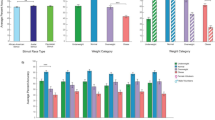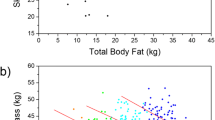Abstract
Purpose
To explore intersectional differences in weight perception accuracy in a diverse sample of young adults using CDC-defined weight status labels and four separate figure rating scales (FRS).
Methods
This cross-sectional study of 322 18–25-year-olds with body mass index (BMI) ranging from 18.5 to 57.2 (MBMI = 26.01, SD = 6.46) enrolled participants as part of a larger university subject pool cohort in the U.S. MidSouth. Height and weight measurements were obtained. Participants (55% Black, 45% white; 74% female) selected images that best represented their current body size using four FRS and described their weight perception using five labels from “very underweight” to “very overweight/obese”. Receiver operating characteristic (ROC) curve analyses were used to compare variability in classification of weight status by FRS and weight perception category across gender and race.
Results
Area under the curve (AUC) statistics indicated all scales were significantly better at classifying weight status than chance. Among Black females and Black males, the culturally adapted scale had the strongest discriminatory ability [(AUC = 0.93, SE = 0.02, p < 0.001, 95% CI = 0.89–0.97) and (AUC = 0.93, SE = 0.04, p < 0.001, 95% CI = 0.86–1.00), respectively]. Among white females, the silhouette scale had the strongest discriminatory ability (AUC = 0.93, SE = .03, p < 0.001, 95% CI = 0.88–0.99). Among white males, the photo-based scale had the strongest discriminatory ability (AUC = 0.84, SE = 0.06, p = 0.001, 95% CI = 0.71–0.96). Across all groups, weight perception labels were the weakest classifier of weight status.
Conclusion
Weight perception labels are an ineffective method of assessing weight status and FRS accuracy varies by race and gender, suggesting the value of gender- and culturally tailored scales.
Level of evidence
Level III. Evidence obtained from well-designed cohort or case-control analytic studies.


Similar content being viewed by others
Data availability
The data that support the findings of this study are available from the corresponding author upon reasonable request.
Code availability
Not applicable.
Notes
Race is a political and social construct that often serves as a proxy for the impact of racist practices and structural inequality, it is not a biological variable and thus is examined in the paper with this premise in mind (for additional review see [9, 10]). We have chosen to capitalize Black to indicate the shared culture and history of Black and African American people in the United States and to raise awareness about the marginalization of Black identity.
References
Hahn SL, Borton KA, Sonneville KR (2018) Cross-sectional associations between weight-related health behaviors and weight misperception among US adolescents with overweight/obesity. BMC Public Health 18(1):514. https://doi.org/10.1186/s12889-018-5394-9
Hazzard VM, Hahn SL, Sonneville KR (2017) Weight misperception and disordered weight control behaviors among U.S. high school students with overweight and obesity: associations and trends, 1999–2013. Eat Behav 26:189–195. https://doi.org/10.1016/j.eatbeh.2017.07.001
Ali MM, Fang H, Rizzo JA (2010) Body weight, self-perception and mental heatlh outcomes among adoelscents. J Mental Health Policy Econ 13:53–63
Edwards NM, Pettingell S, Borowsky IW (2010) Where perception meets reality: self-perception of weight in overweight adolescents. Pediatrics 125(3):e452-458. https://doi.org/10.1542/peds.2009-0185
Duncan DT, Wolin KY, Scharoun-Lee M, Ding EL, Warner ET, Bennett GG (2011) Does perception equal reality? Weight misperception in relation to weight-related attitudes and behaviors among overweight and obese US adults. Int J Behav Nutr Phys Act 8:20. https://doi.org/10.1186/1479-5868-8-20
Sonneville KR, Thurston IB, Milliren C, Kamody RC, Gooding HC, Richmond TK (2016) Helpful or Harmful? Prospective association between weight misperception and weight gain among overweight and obese young adults. Int J Obes 40(2):328–332
Thurston IB, Sonneville KR, Milliren CE, Kamody RC, Gooding HC, Richmond TK (2016) Cross-sectional and prospective examination of weight misperception and depressive symptoms among youth with overweight and obesity. Prev Sci 4:1–12. https://doi.org/10.1007/s11121-016-0714-8
Sonneville KR, Thurston IB, Milliren CE, Gooding HC, Richmond TK (2016) Weight misperception among young adults with overweight/obesity associated with disordered eating behaviors. Int J Eat Disord 49(10):937–946. https://doi.org/10.1002/eat.22565
Roberts DE (2011) Fatal invention: how science, politics, and big business Re-create Race in the twenty-first century. New Press
Smedley A, Smedley BD (2005) Race as biology is fiction, racism as a social problem is real: anthropological and historical perspectives on the social construction of race. Am Psychol 60(1):16–26
Ogden CL, Carroll MD, Lawman HG, Fryar CD, Kruszon-Moran D, Kit BK, Flegal KM (2016) Trends in obesity prevalence among children and adolescents in the United States, 1988–1994 through 2013–2014. J Am Med Assoc 315(21):2292–2299. https://doi.org/10.1001/jama.2016.6361
Kotecki J, Kandiah J, Greene M, Khubchandani J (2019) Weight misperception in young adults: race and gender based disparities (P04–108–19). Curr Dev Nutr. https://doi.org/10.1093/cdn/nzz051.P04-108-19
Smalley KB, Warren JC, Morrissey BD (2017) Discrepancy between actual and perceived weight status in rural patients: variations by race and gender. J Health Care Poor Underserved 28(1):514–527. https://doi.org/10.1353/hpu.2017.0037
Lewis DW, Dutton GR, Affuso O (2015) Physical characteristics associated with weight misperception among overweight and obese men: NHANES 1999–2006. Obesity (Silver Spring, Md) 23(1):242–247. https://doi.org/10.1002/oby.20930
Stunkard AJ, Sorensen T, Schulsinger F (1983) Use of the danish adoption register for the study of obesity and thinness. Res Pub Assoc Res Nerv Mental Dis 60:115–120
Anderson LA, Janes GR, Ziemer DC, Phillips LS (1997) Diabetes in urban African Americans. Body image, satisfaction with size, and weight change attempts. Diabetes Educ 23(3):301–308
Mitola AL, Papas MA, Le K, Fusillo L, Black MM (2007) Agreement with satisfaction in adolescent body size between female caregivers and teens from a low-income African-American community. J Pediatr Psychol 32(1):42–51. https://doi.org/10.1093/jpepsy/jsl004
Harris CV, Bradlyn AS, Coffman J, Gunel E (2005) BMI-based body size guides for women and men: development and validation of a novel pictorial method to assess weight-related concepts. Int J Obes 32(2):336–342. https://doi.org/10.1038/sj.ijo.0803704
Latner JD, Stunkard AJ, Wilson GT (2005) Stigmatized students: age, sex, and ethnicity effects in the stigmatization of obesity. Obes Res 13(7):1226–1231. https://doi.org/10.1038/oby.2005.145
Perez-Lopez MS, Lewis RJ, Cash TF (2001) The relationship of antifat attitudes to other prejudicial and gender-related attitudes1. J Appl Soc Psychol 31(4):683–697. https://doi.org/10.1111/j.1559-1816.2001.tb01408.x
Centers for Disease Control and Prevention (2015) About Adult BMI. http://www.cdc.gov/healthyweight/assessing/bmi/adult_bmi/.
Youngstrom EA (2014) A primer on receiver operating characteristic analysis and diagnostic efficiency statistics for pediatric psychology: we are ready to ROC. J Pediatr Psychol 39(2):204–221
Swets JA, Dawes RM, Monahan J (2000) Psychological science can improve diagnostic decisions. Psychol Sci Pub Interest 1(1):1–26
Hanley JA, McNeil BJ (1983) A method of comparing the areas under receiver operating characteristic curves derived from the same cases. Radiology 148(3):839–843
Volger S, Vetter ML, Dougherty M, Panigrahi E, Egner R, Webb V, Thomas JG, Sarwer DB, Wadden TA (2012) Patients’ preferred terms for describing their excess weight: discussing obesity in clinical practice. Obesity 20(1):147–150
Puhl RM, Himmelstein MS, Armstrong SC, Kingsford E (2017) Adolescent preferences and reactions to language about body weight. Int J Obes 41(7):1062–1065
Rose KL, Leonard KC, Chang T, Miller AL, Nichols LP, Plegue MA, Sonneville KR (2019) Responses to the word obese: definitions, associations, and assumptions made by adolescents and emerging adults. Stigma Health 4:10–13
Puhl RM (2020) What words should we use to talk about weight? A systematic review of quantitative and qualitative studies examining preferences for weight-related terminology. Obes Rev 21(6):e13008
Dorsey RR, Eberhardt MS, Ogden CL (2009) Racial/ethnic differences in weight perception. Obesity (Silver Spring, Md) 17(4):790–795. https://doi.org/10.1038/oby.2008.603
Acknowledgements
We would like to thank Mollie Anderson, Robin Hardin, and Jamie Padden, for their assistance with data collection for this project. We would also like to thank the young adults at the University of Memphis who participated in this study.
Funding
The authors did not receive any funding for conducting this study.
Author information
Authors and Affiliations
Corresponding author
Ethics declarations
Conflict of interest
The authors have no conflicts of interest to declare that are relevant to the content of this article.
Ethics approval
The questionnaire and methodology for this study was approved by the Human Research Ethics committee of the University of Memphis (IRB#: 3070).
Consent to participate
Informed consent was obtained from all individual participants included in the study.
Consent for publication
Not applicable.
Additional information
Publisher's Note
Springer Nature remains neutral with regard to jurisdictional claims in published maps and institutional affiliations.
Rights and permissions
About this article
Cite this article
Thurston, I.B., Decker, K.M., Kamody, R.C. et al. The scale matters: assessing body size with figure rating scales in a diverse sample of young adults. Eat Weight Disord 27, 263–271 (2022). https://doi.org/10.1007/s40519-021-01166-9
Received:
Accepted:
Published:
Issue Date:
DOI: https://doi.org/10.1007/s40519-021-01166-9




